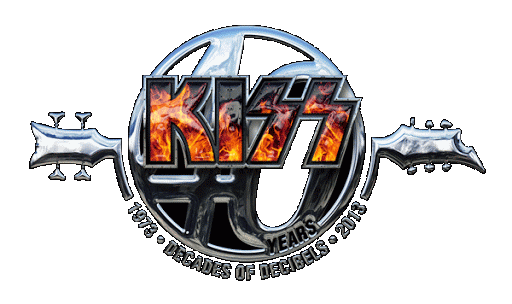By Russell Hall/ Music & Musicians
For a long time, beginning in 1999, Paul Stanley wasn’t sure Kiss would make
another studio album. Worse, he wasn’t sure he wanted to. Ironically, it was the
making of the previous year’s Psycho Circus—the much-ballyhooed record
that featured original members Peter Criss and Ace Frehley reunited with Kiss
founders Stanley and Gene Simmons—that put Stanley in that frame of mind. As he
tells it, Criss and Frehley were recalcitrant participants, at best.
“What we learned is that you can’t make a great Kiss album without Kiss,” he
says. “When there are two people in the studio working, and two who are refusing
to come in, or who have their attorneys on the phone all the time, that’s not a
good situation. Psycho Circus was interesting in the sense that it made
me never want to go back into the studio, and at the same time, I felt I’ll be
damned if that was going to be the last album we made. The band, during the
reunion period, went south pretty quickly. It was something we managed to keep
alive in much the same way a paramedic might keep a stroke victim from
dying.”
To say Stanley and Simmons have kept Kiss alive is an understatement. Since
the group’s 1974 self-titled debut, Kiss has released 20 studio albums, 10 live
records and 13 compilation discs. Including solo records, they’ve been awarded
28 gold albums, more than any American rock group. Worldwide album sales are
colossal—more than 100 million.
There’s another facet to that success—the group’s merchandising empire, and
it’s unrivalled in rock. The Kiss brand offers everything from baby bibs to
action figures to caskets (spelled Kaskets, of course). There’s also a miniature
golf course, a coffeehouse and even a Kiss Kruise. The vast array of goods is
served up without apology. “It all begins with the songs, no question about
that,” says Simmons. “But there were never any rules for being in a rock band.
People just thought there were. For us, it’s not enough to just be a Radiohead
or a U2. That’s why we have 3,000 licensed products.”
Kiss continued to tour after Psycho Circus, albeit in ever-changing
configurations. Criss left in 2001, replaced by Eric Singer, who had previously
served as the band’s drummer in the early ’90s. Frehley departed the following
year, and longtime Kiss associate Tommy Thayer stepped in as replacement on lead
guitar. Thayer’s position was made permanent, but in 2003 Criss returned for
KISS Symphony: Alive IV, a concert album with Australia’s Melbourne
Symphony Orchestra. A year later, Criss was out, Singer was back.
Since then, the lineup of Stanley, Simmons, Thayer and Singer has coalesced
into a finely tuned rock machine that has achieved its greatest success on the
road. World tours in 2008 and 2009 solidified the group’s status as a premier
live act, as the band’s chemistry rose to a level commensurate with the group’s
spectacular stage show. In 2010—following a decade of resistance to the
idea—Kiss released Sonic Boom, a no-frills studio album that captured
the band’s sound from their mid-’70s heyday.
Kiss’ latest, Monster—produced by Stanley and production vet Greg
Collins—fully embraces a stripped-down, back-to-basics approach. “No boys’
choirs, no symphony orchestras, just meat and potatoes,” says Simmons, alluding
to the adherence to two guitars, bass and drums. The goal? Raise the bar while
keeping things simple. “We sat facing each other as we recorded,” he says. “The
idea was to get things in the first, second or third take. I didn’t want to lose
any of the urgency and passion of what we were doing.”
Simmons and Stanley emphasize that no other Kiss configuration could have
made Monster. The spirit of camaraderie is evident in the song credits.
Thayer wrote or co-wrote nine of the 12 songs, and Singer co-wrote one tune and
takes lead vocals on the Stanley-penned anthem, “All for the Love of Rock and
Roll.” “This lineup is the embodiment of everything the band wanted to be,” says
Stanley. “To think any other lineup could have made this album would be enough
to get you committed. I’ve been there from the beginning, and I know.” Stanley
and Simmons discussed the music behind the theater, their creative partnership
and the Kiss legacy.
Was there a goal with Monster?
STANLEY: To hark back to the music and artists who influenced us and capture
that spirit. That doesn’t mean copying anybody. It means finding that spot they
touched. I grew up hearing bands at the Fillmore East nearly every weekend.
Those bands played like their lives depended on it. There was also a joy. It
almost felt like being in church, like gospel. James Brown didn’t go for
perfection—he went for passion. Same was true for Motown, the Beatles, Led
Zeppelin, the Who, the Stones, early Elvis and on and on. Sonic
Boom stayed close to our past, to things we had done previously. But for
Monster, I wanted to make the album we never made.
What was your role as producer?
STANLEY: To set ground rules. It’s important that everyone know what the
expectations are. One rule was no outside co-writes, just like the last album. I
wanted to make sure everyone was totally committed to making this album—and that
we all understood there were no quotas, no entitlements. It doesn’t matter if
you’ve been in the band 10 years or 30 years—if the songs aren’t good enough,
they don’t go on. Once those parameters are made clear, everyone is willing to
work harder. That said, we never had more fun making an album.
Continue Reading

No comments:
Post a Comment